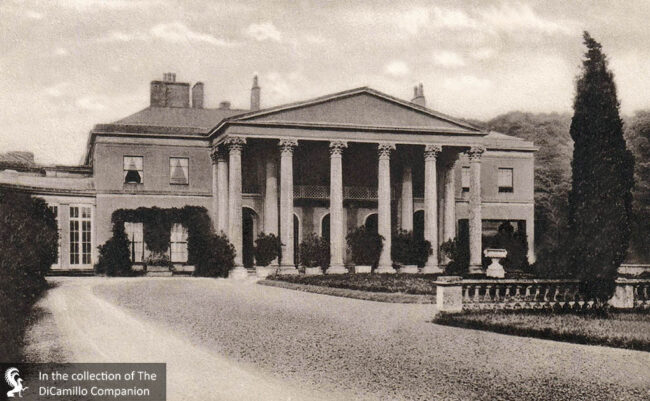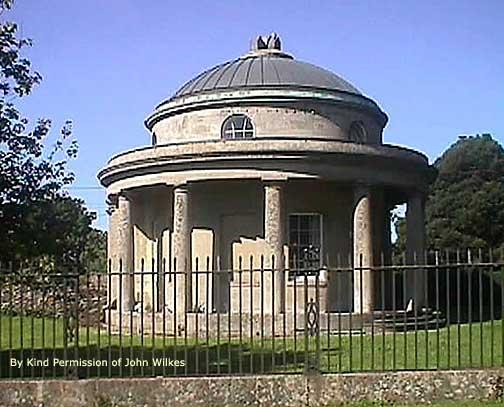
The house from an 1825 engraving

The entrance facade from a circa 1920 postcard

The house from a circa 1895 postcard

The stables from a circa 1905 postcard

The Round Lodge
Earlier Houses: There were at least two earlier houses on, or near, the site of the current house. The earliest of these was the moated Medieval house of the Berkeley family, which was replaced circa 1560 by an Elizabethan house erected by Robert Wickes. Though the family can trace its roots in the area to as early as the 14th century (John Codrington was standard-bearer to Henry V at Agincourt and Harfleur in 1415), it wasn't until 1578 that Giles Codrington purchased Wickes's Elizabethan house (it was this house that was painted in a series of watercolors by Turner around 1796). Between 1797 and 1798 the Elizabethan house was demolished by Christopher Bethell-Codrington, who replaced it with the current James Wyatt-designed Neoclassical house.
Built / Designed For: Christopher Bethell-Codrington
House & Family History: Work on the new house started in 1798, but was not finished until 1813 because Bethell-Codrington did not borrow to build Dodington Park, but constructed it piece-by-piece, as estate income allowed. The house is almost square and occupies 35,000 square feet. On the west façade is the main entrance, which is housed within an enormous Greek style portico with colossal Roman Corinthian columns, the spacing of which allowed carriages to access it as a porte-cochère. Dodington is particularly noted for its large entrance hall and its grand staircase. Modeled on an ancient Roman atrium, the entrance hall has scagliola porphyry Composite columns and a floor of pink, black, and white stone inlaid with strips of brass (the pattern of the floor repeats that of the ceiling). The huge imperial staircase sweeps up into a grand domed hall, one of Wyatt’s most masterful creations. The staircase was designed to incorporate the circa 1760 wrought iron Rococo balustrade from Fonthill Splendens (Wyatt very likely planned to use this balustrade at Dodington, for, at the same time that he was building Dodington, he was demolishing Fonthill Splendens and building Fonthill Abbey for another client, the eccentric William Beckford). Somewhat ironically, Wyatt was killed in a carriage accident on September 14, 1813 on his way from Dodington to London. He was traveling with Christopher Bethell-Codrington (who was unhurt), for whom he had just finished Dodington Park. The Codringtons made their fortune in the West Indian sugar and slave trade. Colonel Christopher Codrington (circa 1640-98), ancestor of Christopher Bethell-Codrington (who built the current house), purchased the island of Saint Lucia from native chiefs in 1663. He went on to build up the largest land holdings in Antigua and later secured a lease of the entire island of Barbuda from the British Crown. Codrington, one of the largest slave owners in the British Empire, was not, unsurprisingly, a pillar of virtue. In 1669 he was accused of murdering Henry Willoughby, son of Lord Willoughby, the governor of Barbados. Codrington was involved in a dispute with the governor about the acquisition of a desirable estate on Barbados called Consetts. A few hours after dining with Codrington, Henry Willoughby died suddenly with a “violent burning of the stomach.” Though poison was suspected, no wrongdoing was ever proved; however, Codrington’s reputation never recovered, though he continued to find many ways to line his pockets. At the time of his death in 1698, he was the target of allegations of corruption. Col. Codrington was the founder of Codrington College in Barbados and founded the college library at All Souls, Oxford, which he endowed with the enormous sum of £10,000 upon his death. Christopher Bethell-Codrington, like his ancestor, was a strong supporter of enslavement and opposed the abolition of slavery in the British Empire, offering as evidence an 1825 letter from his manager in Barbuda, John James, that testified to the happiness and contentment of his slaves there. In the 1830s, when the British government emancipated Bethell-Codrington's almost 500 slaves, he was given £30,000 (approximately £25 million in 2019 values using the labour value commodity index) by the government as compensation for his loss of property. The Codrington family sold up in the 1980s and two reclusive gentlemen subsequently acquired the estate. In early 2003 Dodington was sold for £15 million to inventor James Dyson, who made his fortune with the famous high suction cyclone vacuum cleaners that bear his name.
Comments: Dodington is regarded as one of Wyatt's crowning achievements and his finest house in the classical style. Christopher Hussey, describing Dodington's interiors: “…controlled splendour that is magnificent.”
Garden & Outbuildings: Alexander Pope visited Dodington in 1728 and his description of the park, already in existence, shows an early appreciation of the Picturesque-designed landscape: "pretty enough, the setting romantic, covered with woody hills stumbling upon one another and the garden makes a lovely valley between them with some mounts and waterfalls." In 1764 Capability Brown created new vistas, undulations, and the two lakes; one of his supreme creations at Dodington, the two lakes are a minor masterpiece of engineering—the higher lake flows into the lower one by way of a Gothic cascade. Today the estate comprises 300 acres and contains a stableblock with clock tower (containing 24 stalls, three apartments, and workshops) and a fine carriage house. In addition, there are eight houses (seven of which are listed, including the dower house, a large house with a walled garden), an indoor riding school, an ice house, and a pigeon loft. Dodington was one of the first country houses to install gas for lighting, which was accomplished by building a gas house on the estate in 1828.
Chapel & Church: St. Mary's, a magnificent Greek cross style church designed by James Wyatt circa 1800-05, is connected to the house via a curved conservatory with 18-foot windows. The Grade I-listed building, with a dark green and white marble floor, is crowned by a saucer dome that rises from segmental arches to vaults with Doric columns. During World War II Queen Mary regularly worshiped at St. Mary's, commuting from nearby Badminton House, where she spent most of the war.
Architect: James Wyatt
Date: Circa 1800-05Architect: James Wyatt
Date: 1798-1813Country Life: LV, 170, 1924. CXX, 1176, 1230, 1956.
Title: English Country Houses: Late Georgian, 1800-1840
Author: Hussey, Christopher
Year Published: 1966
Reference: pgs. 42, 45, 48, 51, 52, 53, 54
Publisher: London: Country Life Limited
ISBN: NA
Book Type: Hardback
Title: Times, The (London newspaper)
Author: NA
Year Published: NA
Reference: Jan 21, 2003, News Section, pg. 3
Publisher: London: Times Newspapers Ltd.
ISBN: NA
Book Type: Newspaper
Title: Times Magazine, The (London newspaper magazine)
Author: NA
Year Published: NA
Reference: Nov 29, 2002, pgs. 8-9
Publisher: London: Times Newspapers Ltd.
ISBN: NA
Book Type: Newspaper
Title: Biographical Dictionary of British Architects, 1600-1840, A - SOFTBACK
Author: Colvin, Howard
Year Published: 1995
Reference: pgs. 1113, 1118
Publisher: New Haven: Yale University Press
ISBN: 0300072074
Book Type: Softback
Title: Disintegration of a Heritage: Country Houses and their Collections, 1979-1992, The
Author: Sayer, Michael
Year Published: 1993
Publisher: Norfolk: Michael Russell (Publishing)
ISBN: 0859551970
Book Type: Hardback
House Listed: Grade I
Park Listed: Grade II*
Current Seat / Home of: James and Deidre Dyson; here since 2003.
Past Seat / Home of: SEATED AT EARLIER HOUSES: Berkeley family, here from the 11th century until the 15th century. Robert Wickes, mid-16th century. Giles Codrington, late 16th century; Colonel Christopher Codrington, until 1698; Sir William Codrington, 1st Bt. (first creation), until 1738; Sir William Codrington, 2nd Bt., 1738-92. SEATED AT CURRENT HOUSE: Christopher Bethell-Codrington, 1800-43; Sir Christopher William Codrington, 1843-64; Sir Gerald William Henry Codrington, 1st Bt. (second creation), 1864-1929; Sir Christopher William Gerald Henry Codrington, 2nd Bt., 1929-79; Codrington family here from the 16th century until the 1980s.
Current Ownership Type: Individual / Family Trust
Primary Current Ownership Use: Private Home
House Open to Public: No
Historic Houses Member: No